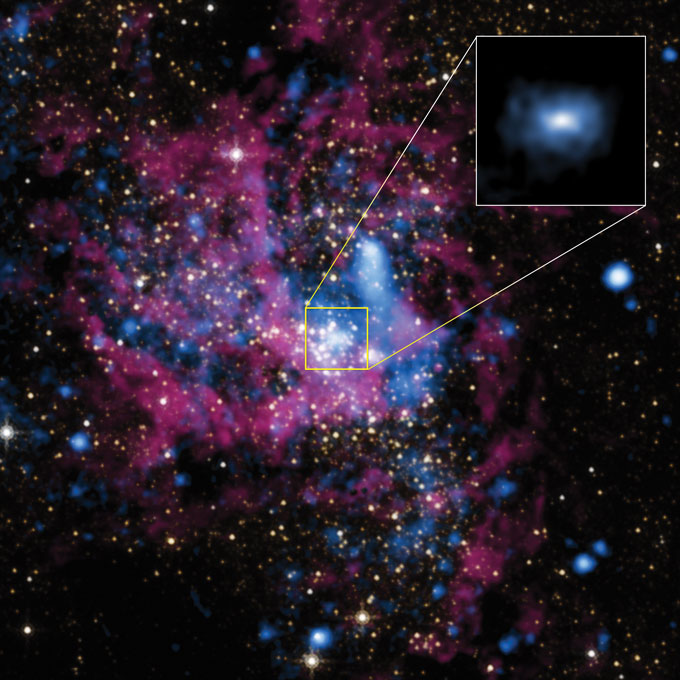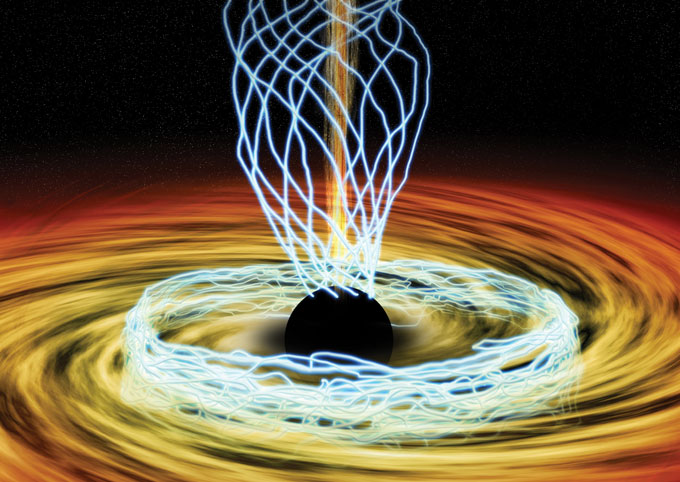2019 brought us the first image of a black hole. A movie may be next
The Event Horizon Telescope team is gearing up for more discoveries

The black hole at the center of the galaxy M87 came into view this year.
Event Horizon Telescope Collaboration
Black holes are notoriously bashful beasts. The supermassive monsters that dwell at the centers of galaxies weigh millions to billions of times the mass of the sun and control the fates of everything in their vicinity, including light. Despite such outsize influence over their home galaxies, black holes never show their faces.
Until now. After more than a decade of work, results from the Event Horizon Telescope, or EHT, stunned the world this year with the first direct image of a black hole’s event horizon, the region beyond which not even light can escape.
To make this remarkable image, scientists cobbled together a massive “telescope” by connecting seven observatories around the world to create a tool effectively the size of Earth (SN: 4/27/19, p. 7). The result: a picture of the round silhouette of a black hole against the ringlike backdrop of its brightly glowing accretion disk, the gas and other material drawn in by the black hole’s voracious gravitational appetite.
Almost immediately, that image shored up Einstein’s general theory of relativity, weighed in on the best way to measure a black hole’s mass (SN Online: 4/22/19) and provided evidence that event horizons are real. Now the EHT team is digging into what else the telescope’s vast amount of data can reveal, in the hopes of cracking more black hole mysteries.
“This is just the beginning of this kind of new era of observing event horizons,” says Kazu Akiyama, an EHT team member and astrophysicist at the MIT Haystack Observatory in Westford, Mass.
The initial black hole snapshot, unveiled in April, focused on a distant galaxy, M87 (SN: 4/27/19, p. 6). At roughly 6.5 billion solar masses, M87’s black hole is about 1,600 times as massive as EHT’s other target, the black hole in the center of the Milky Way. That black hole, Sagittarius A*, also known as Sgr A*, weighs about 4 million times the mass of the sun.
Being more massive made M87’s giant an easier subject. Gases swirling around that black hole were more sluggish and changed brightness less often and less dramatically than those moving more nimbly around Sgr A*.
“M87 was sitting still for its portrait,” says EHT team member Andrew Chael, an astrophysicist at Princeton University. “Sgr A* is like a cheetah running across the frame.”
We summarize the week's scientific breakthroughs every Thursday.
In data collected during a week in April 2017, Sgr A* changed its appearance over the course of a few minutes. So while M87’s black hole lent itself to a single still image, “for Sgr A*, we may need to construct a movie,” Akiyama says.
The simplest way to make a movie would be to break up one night’s observations into segments, make an image from each segment and string them together, says EHT team member Katie Bouman, a data scientist at Caltech. But there’s not enough information in even the smallest segment to produce a reliable image. “You reconstruct nonsense,” she says.
Instead, the team is working on techniques to fill in gaps and carry information about the black hole’s appearance forward in time. “We assume that although the source is evolving, it’s not evolving randomly — there is some continuity in how the gas is moving around the black hole,” Bouman says. By stitching together a movie that plays smoothly, she and colleagues hope to understand the black hole’s structure.

Getting a good look at Sgr A*’s event horizon will give physicists one of the best tests yet of general relativity, says physicist Feryal Özel of the University of Arizona in Tucson. The century-old theory predicts how the mass of a black hole warps spacetime (SN: 10/17/15, p. 16). General relativity also makes precise predictions for the size of the bright ring and dark silhouette for black holes of a given mass.
M87’s black hole was too far away for astronomers to know precisely its mass before capturing the image. But Sgr A*’s mass is well known, thanks to decades of measurements of stars orbiting the Milky Way’s black hole. Capturing Sgr A*’s image would be “a clean test of some of the things we want to look at,” Özel says. “The ring and the shadow, it either is the size you expect or it’s not…. That’s an incredible opportunity for us.”
A movie of M87’s black hole may be in the works, too. “Our observations provided good evidence that M87 is actually changing [within] the timescale of a week,” Akiyama says. Studying how the black hole changes could reveal details of how it rotates, spinning magnetized plasma around it like a dancer’s skirt.
Among other treasures waiting in already collected data is the polarization of light emitted from the bright ring of M87’s black hole. This measure of the orientation of light waves — wiggling up and down, left and right, or at an angle — lets scientists determine the arrangement of strong magnetic fields near the black hole. Those magnetic fields are thought to control how the black hole accretes matter.
The arrangement “tells you how the black hole eats,” says astrophysicist and EHT team member Michael Johnson of the Harvard-Smithsonian Center for Astrophysics in Cambridge, Mass. Black holes are known for their hearty appetites, but actually “it’s extremely difficult to fall into a black hole,” he says. An orbiting bit of matter will just keep orbiting forever unless some friction or viscosity in the environment drags it toward the black hole.
Physicists think magnetic fields are what make the environment around black holes viscous. In 2015, Johnson and colleagues published EHT observations of the polarization around Sgr A*, which showed tangled magnetic fields close to the black hole and more organized fields farther away. But those observations came from just four telescopes.

“We have this beautiful theory of why black holes can eat, but we’ve never seen evidence for it,” Johnson says. “So if EHT can see these magnetic fields, we might have our first glimpse into this accretion process.”
Polarization could also help explain one mysterious feature of M87: It launches a bright, energetic jet that extends light-years into space. Magnetic fields that get twisted around the black hole as it spins are important for launching the jet, physicists think, but the details are murky.
“If we could see this polarization, we might be able to see these processes directly — the magnetic fields and the jet and how they’re connected to the black hole,” Johnson says.
EHT will fire up again in April 2020, this time with 11 observatories, including Kitt Peak in Arizona and NOEMA in the French Alps. Further in the future, EHT scientists are considering sending a telescope to space. Extending EHT into Earth’s orbit would alleviate worries about weather on the ground ruining observations — and would help make even sharper images of even more black holes.







